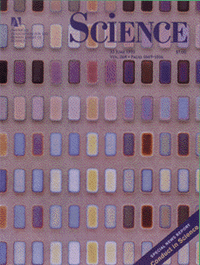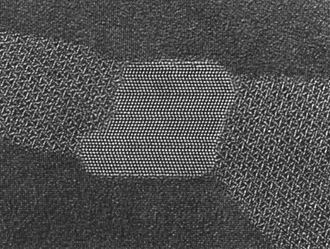





| 
| 
| 
| 
|

| "Combinatorial synthesis," a new tool developed at Berkeley Lab, lets scientists make and test thousands of hi-tech materials in the time it normally takes to make and test one. First-year results of the research made the cover of Science magazine in June, 1995. Pictured is a 128-member combinatorial library of high-temperature superconductors created on a square-inch chip. |
 The surface science experimental station is located on ALS beamline 9.3.2, a
bend-magnet beamline that produces photons between 30 and 1500 electron volts in
energy. This energy range permits the study of both the inner "core" as well as
the outer "valence" electrons of all elements. The station is designed
specifically for photoelectron spectroscopy and photoelectron
diffraction-collectively known as PES/PED-two of the most powerful techniques
known to science for the study of solid surfaces.
The surface science experimental station is located on ALS beamline 9.3.2, a
bend-magnet beamline that produces photons between 30 and 1500 electron volts in
energy. This energy range permits the study of both the inner "core" as well as
the outer "valence" electrons of all elements. The station is designed
specifically for photoelectron spectroscopy and photoelectron
diffraction-collectively known as PES/PED-two of the most powerful techniques
known to science for the study of solid surfaces.
 At this new experimental station, Berkeley Lab researchers working with users
from outside the Laboratory will be able to obtain detailed information on what
types of atoms are present on a surface, how many there are of each type, and how
they are arranged in space. It will also be possible to identify the chemical or
magnetic states of these atoms, and in some cases
to produce holographic images. The information learned will provide U.S. chip
manufacturers with a big advantage in their efforts to fabricate nanoscale
semiconductor and magnetic storage devices.
At this new experimental station, Berkeley Lab researchers working with users
from outside the Laboratory will be able to obtain detailed information on what
types of atoms are present on a surface, how many there are of each type, and how
they are arranged in space. It will also be possible to identify the chemical or
magnetic states of these atoms, and in some cases
to produce holographic images. The information learned will provide U.S. chip
manufacturers with a big advantage in their efforts to fabricate nanoscale
semiconductor and magnetic storage devices.
 Nanoscale devices are so small they become two- or even one-dimensional
objects-essentially nothing but surfaces and interfaces. Another critical factor
in bringing nanotechnology to fruition will be a better understanding of how
electrons move through materials that are less than three-dimensional. Berkeley
Lab scientists studying the dynamics of electrons at surfaces made strides
recently with the solution of a long-standing problem concerning the effect on
the motions of electrons near a metal surface when that surface is coated with
thin films of an insulating material. Making good use of new lasers that can
deliver tunable pulses of light only 100 femtoseconds in duration (one
femtosecond is a millionth of a billionth of a second), the scientists have been
able to follow electrons as they move back and forth across the interface between
a metal surface and an insulating film of molecules. They've also been able to
vary the thickness of the insulating film by a single layer of molecules at a
time in order to study the effects on electron movements as devices increase from
two dimensions to three. What made this research possible in addition to
femtosecond lasers was a technique called "two-photon photoemission" and an
unusual electron time-of-flight detection scheme that gives unprecedented
sensitivity and highly precise energy measurements.
Nanoscale devices are so small they become two- or even one-dimensional
objects-essentially nothing but surfaces and interfaces. Another critical factor
in bringing nanotechnology to fruition will be a better understanding of how
electrons move through materials that are less than three-dimensional. Berkeley
Lab scientists studying the dynamics of electrons at surfaces made strides
recently with the solution of a long-standing problem concerning the effect on
the motions of electrons near a metal surface when that surface is coated with
thin films of an insulating material. Making good use of new lasers that can
deliver tunable pulses of light only 100 femtoseconds in duration (one
femtosecond is a millionth of a billionth of a second), the scientists have been
able to follow electrons as they move back and forth across the interface between
a metal surface and an insulating film of molecules. They've also been able to
vary the thickness of the insulating film by a single layer of molecules at a
time in order to study the effects on electron movements as devices increase from
two dimensions to three. What made this research possible in addition to
femtosecond lasers was a technique called "two-photon photoemission" and an
unusual electron time-of-flight detection scheme that gives unprecedented
sensitivity and highly precise energy measurements.
 Berkeley Lab scientists this past year also successfully demonstrated the
first ever catalysis on a nanometer scale. Working with UC Berkeley researchers,
they modified an Atomic Force Microscope so that it functioned like an
ultrafine-point pen for catalytic calligraphy. With this unique new tool, they
were able to create a reaction that changed the chemical composition of the
surface of a material one molecule at a time.
Berkeley Lab scientists this past year also successfully demonstrated the
first ever catalysis on a nanometer scale. Working with UC Berkeley researchers,
they modified an Atomic Force Microscope so that it functioned like an
ultrafine-point pen for catalytic calligraphy. With this unique new tool, they
were able to create a reaction that changed the chemical composition of the
surface of a material one molecule at a time.

| Scintists at NCEM, in collaboration with General Motors, are helping to develop new alloys for the next generation of automobiles. This micrograph, taken on the Atomic Resolution Microscope, characterizes alloy phases in an experimental composite material for piston rings. |
 This unprecedented demonstration of molecular synthesis on such a tiny scale
represents a promising step towards the development of nano-fabrication. One key
to its success was the combination of atomic force microscopy with a technique
from organic chemistry called molecular self-assembly. Another key was performing
the research at a multiprogram national laboratory where chemists and physicists
can and do work together.
This unprecedented demonstration of molecular synthesis on such a tiny scale
represents a promising step towards the development of nano-fabrication. One key
to its success was the combination of atomic force microscopy with a technique
from organic chemistry called molecular self-assembly. Another key was performing
the research at a multiprogram national laboratory where chemists and physicists
can and do work together.

| 
| 
| 
|